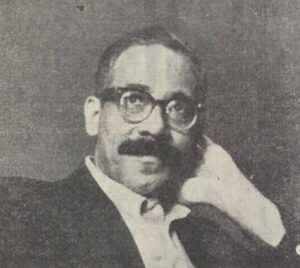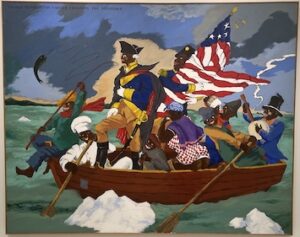Mildred Wilson
Michigan, United States

In 1975, satirist Robert Colescott turned the art community on its head with Eat Dem Taters, a parody of van Gogh’s The Potato Eaters.1,2 He and other postmodernist painters of the period would appropriate images from other artists’ paintings, questioning the concept of originality,2 and his George Washington Carver Crossing the Delaware (an appropriation of Leutze’s Washington Crossing the Delaware) soon became his most famous. For these works and for others—and much to his chagrin—Colescott became known as the man who “paints art history in blackface.”3
Born on August 6, 1925, in Oakland, California, Colescott was the son of Warrington Wickham Colescott, Sr., a waiter on the Southern Pacific Railroad, and Lydia Kenner Hutton. His parents had migrated from New Orleans to California in 1919. His mother was descended from slaves belonging to two prominent Southerners, William McWillie, Governor of Mississippi prior to the Civil War,4 and his partner Chapman Levy, a Jewish lawyer who owned a brickyard and thirty slaves.5 Colescott’s father was the son of a white man and a woman alleged to be part black, part white, and part Native American.6
Colescott and his older brother Warrington, Jr. attended local schools in Oakland. After high school, Warrington, Jr., enrolled at the University of California, Berkeley (UCB). Robert postponed college, volunteering in 1944 for service in the Army.7
Their parents were light-skinned enough to pass for white, which they did after moving to Oakland.6 Neither Colescott’s mother nor his brother identified as black, and Colescott, being darker, was rejected by his mother. However, his father, low-keyed regarding racial identity, had served in the US Army in World War I in the “Colored” unit. Even though Robert sympathized with him, he registered as “White.”7
In 1946, Colescott enrolled at San Francisco State University, though transferred to Berkeley after a year. In 1949, he received a Bachelor of Arts in Art Practice.6 Encouraged by James McCray, a distinguished painter and professor at UCB, he traveled to Paris to study under the famous Fernand Leger.7 Leger rejected Colescott’s abstract paintings as not being accessible to ordinary people. Colescott was disappointed, but accepted Leger’s program and began to produce works imitative of his. While in Paris, he met and married Czechoslovak Zdenka Falarova,8 and the two returned to California in 1950. Over the next two years, he earned a master’s in Art Practice and a teaching certificate from UCB. He then taught at two junior high schools in Seattle, WA. Both positions were disappointments, as he had set his hopes on teaching at college level.
By 1957, his work, now emulating that of Dutch-American abstract expressionist artist Willem de Kooning, was gaining attention.8 Colescott was given the position of Assistant Professor in Art Education at Portland State College and was recruited by Arlene Schnitzer to join the Fountain Gallery, later Portland’s most important gallery for contemporary art. Although Colescott gained some popularity with a new focus on landscapes and nudes, he wasn’t satisfied. He began experimenting with a series of collage paintings, and in 1962, he divorced Zdenka to marry Sally Marie Dennett. A son, his third, was born in 1963.
In 1964, after promotion as Associate Professor of Art, he took a year’s sabbatical in Cairo, where he served as Artist in Residence at the American Research Center. The paintings decorating Egypt’s ancient tombs suggested new possibilities for his work.9 He returned to Egypt two years later and worked as Visiting Associate Professor at the American University in Cairo (AUC). He decided to switch from oils to the newly popular acrylics, which dried faster and rolled up more safely, better facilitating shipping. Acrylics were first commercially promoted in the 1960s and were popular with artists such as Andy Warhol, Mark Rothko, and others.10
During his visit to Egypt, Colescott became conscious of the fact that those around him looked like him. He began to question the path he had taken in life and the identity he had fashioned for himself.9
In 1967, he launched the opening of the Corridor Gallery, the first art gallery at AUC.11 His visit was interrupted by the Six-Day War. After a brief stay in Rome, he went to Paris for two years, where he taught visiting American students under the auspices of several programs. Invigorated by this experience, he bought a farm with the intention of establishing a summer program in the arts. The program ran for but a single summer in 1968.12 Without a better plan, the Colescotts accepted summer positions at the North Country School in Lake Placid, New York, in 1969. He was unhappy there, and he and Sally separated. He moved to New York City, to a job in an art supply store.

In 1970, Colescott found a position as Professor of Art at Stanislaus State College in Turlock, California. There was much social unrest following the Civil Rights Movement and anti-Vietnam demonstrations.12 He revived a cartoon style, with which he had begun experimenting in Paris, and his painting Poncho Villa (1971) presented the viewer with a conflict between light and dark-skinned individuals and put it to the viewer to choose a side.13
In 1971, he divorced Sally.14 He remained at Stanislaus State College until 1974, moving on to hold several part-time positions, including Visiting Lecturer at UCB, Instructor of Painting at San Francisco Art Institute, and Visiting Professor at the University of Arizona, Tucson. In 1975, he married Susan Ables; he divorced her in 1978 and remarried her in 1979.
Through all this, Colescott constantly sought a tenured track position at UCB, but was repeatedly turned down, the final time in 1979, when it was rumored that a black woman was hired to satisfy diversity requirements.15 The next year, his fourth son was born, and through 1985, he received three grants from the National Endowment for the Arts and one from the Guggenheim Foundation. He divorced Susan again, married Colleen Dena Hench, and accepted a position as Professor of Art at the University of Arizona, Tucson. In 1986, his fifth son was born.16 Colescott was promoted to Regents Professor of Art four years later. Then, in 1992, he divorced Colleen; he retired from teaching in 1995. He was selected to represent the US at the Venice Biennale in a solo exhibition in 1997 and was the first African American to do so.17 He finally married Jandava Denise Cattron in 2007.18
For several years, Colescott had suffered from Parkinsonian symptoms.19 His particular symptoms are unclear. However, slowness of movement, rigidity, tremors, and gait and balance abnormalities are the usual features.20
For more than four decades, Colescott passed for white. Denying one’s heritage can be emotionally exhausting: isolation, paranoia, guilt, self-hate, fear of being outed.21 Conceivably, Colescott’s illness was exacerbated by a life filled with psychological stress, including rejection by his mother, multiple failed marriages, and loss of family ties. Allegedly, too, from 1979 until his death, he and his brother never spoke.22 He died on June 4, 2009 in Tucson, Arizona.18
Many of Colescott’s paintings forcefully explored issues related to black identity. Recent research indicates that his perspectives on race and social mores are as relevant today as they were three decades ago.23
End notes
- “Robert Colescott,” Wikipedia. https://en.wikipedia.org/wiki/Robert_Colescott.
- Sharon Patton, African American Art (Oxford, England: Oxford University Press, 1998), 234-6.
- Raphaela Platow and Lowery Stokes Sims, eds, and Matthew Weseley, contributor, Art and Race Matters: The Career of Robert Colescott (New York: Rizzoli Electa, 2019), 34.
- Platow and Sims, Art and Race Matters, 13.
- “Chapman Levy,” Wikipedia. https://en.wikipedia.org/wiki/Chapman_Levy.
- Platow and Sims, Art and Race Matters, 15.
- Platow and Sims, Art and Race Matters, 16.
- Platow and Sims, Art and Race Matters, 21.
- Platow and Sims, Art and Race Matters, 27.
- Encyclopaedia Britannica, “Acrylic painting,” last updated June 6, 2023, https://www.britannica.com/art/acrylic-painting.
- Terri Ginsberg, Duncan McDonald, and Matthew Weseley, Robert Colescott: The Cairo Years, American University in Cairo Tahrir Cultural Center Exhibit, February 9 – March 31, 2021.
- Platow and Sims, Art and Race Matters, 28.
- Platow and Sims, Art and Race Matters, 30.
- Platow and Sims, Art and Race Matters, 234.
- Platow and Sims, Art and Race Matters, 178.
- Platow and Sims, Art and Race Matters, 234–5.
- Platow and Sims, Art and Race Matters, 181.
- Platow and Sims, Art and Race Matters, 235.
- Roberta Smith, “Robert Colescott, Painter Who Toyed With Race and Sex, Dies at 83,” New York Times, June 9, 2009, https://www.nytimes.com/2009/06/10/arts/design/10colescott.html.
- “Approach to the Exam for Parkinson’s Disease,” Stanford Medicine: The 25, https://stanfordmedicine25.stanford.edu/the25/parkinsondisease.html.
- Robert Fikes, “The Passing of Passing: A Peculiar American Racial Tradition Approaches Irrelevance,” BlackPast, December, 30, 2014, https://www.blackpast.org/african-american-history/passing-passing-peculiarly-american-racial-tradition-approaches-irrelevance/.
- Platow and Sims, Art and Race Matters, 173.
- Ashely Quarcoo, “Global Democracy Supporters Must Confront Systemic Racism,” Carnegie Endowment for International Peace, July 15, 2020, https://carnegieendowment.org/2020/07/15/global-democracy-supporters-must-confront-systemic-racism.
MILDRED WILSON has a masters in teaching in visual art and a doctorate in curriculum development and administration. She is a former high school art teacher, elementary school principal, and a deputy director and consumer advocate for the Michigan Legislative Service Bureau. Currently, she spends her time caring for her mother, writing, and painting.

Leave a Reply